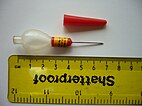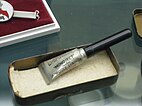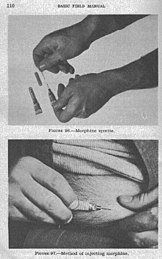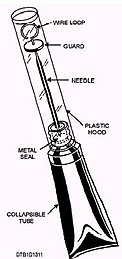A syrette is a single-use device for injecting liquid through a needle. It is similar to a syringe except that it has a sealed squeeze tube instead of a rigid tube and piston. It was developed by the pharmaceutical manufacturer E.R. Squibb & Sons (eventually merged into the current day Bristol-Myers Squibb) just prior to World War II (WWII).[1]
In WWII, the morphine syrette was included in first aid kits. It had a wire loop with a guard at the end of a hollow needle that was used to break a seal where the needle was attached to the tube. The wire loop was then removed and the needle was inserted under the skin at a shallow angle and the tube slowly squeezed from the sealed end (see subcutaneous injection).[2] After injection the used tube was often pinned to the receiving soldier's collar to inform others of the dose administered.[1]
The syrette was adopted for use by the United States Army in 1940.[1] The US military also distributed atropine in syrettes.[citation needed] Chemical treatment was subsequently distributed in autoinjector form.[citation needed]
See also
editReferences
edit- ^ a b c "The painkiller of battlefields". Beaches of Normandy Tours. Retrieved Aug 17, 2024.
- ^ "War Department FM 21-11 Basic Field Manual – First Aid for Soldiers" (PDF). All Americans. April 7, 1943. Retrieved Aug 17, 2024.
External links
edit



